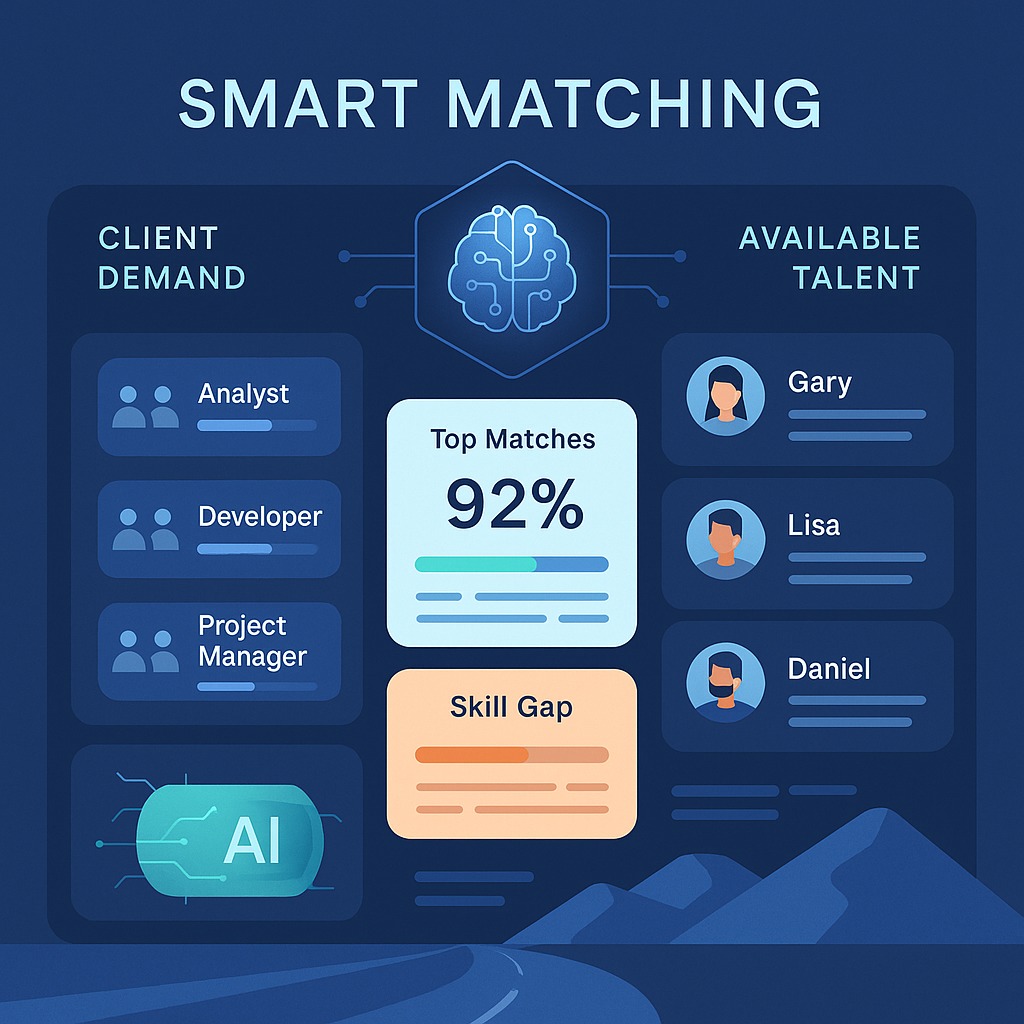Professional Services is a fast-moving industry where success depends on how efficiently organizations can find the right people with the right skills at the right time, place, and cost. Over the years, I’ve seen customers struggle with this, relying on spreadsheets, emails, and disconnected systems to make crucial staffing decisions. While this might work for smaller teams, at scale, it becomes a bottleneck. Companies need a streamlined, technology-driven approach to truly optimize this process.
Understanding the Demand-Supply Matching Process
At its core, resource management in professional services is about matching demand (projects) with supply (talent). I’ve worked with organizations where demand capture happens in an ad-hoc way, leading to rushed hiring decisions and inefficiencies. The process should ideally follow a structured approach:
- Demand Capture – Identifying upcoming project needs from sales pipelines, client discussions, and strategic planning.
- Demand Forecasting – Using historical trends and predictive analytics to estimate future workforce requirements.
- Supply Capture – Maintaining an up-to-date database of employees, skills, certifications, and availability.
- Supply Assessment – Evaluating the workforce to identify gaps and determine if hiring or contractor engagement is required.
- Matching Resources to Projects – Finding the best available talent for specific projects based on experience, skills, and location.
- Matching Projects to Resources – Ensuring that employees are staffed on assignments that align with their career goals and expertise. This is particularly helpful when certain resources are coming off projects.
- Staffing, Allocation, and System Updates – Assigning resources to projects, updating internal systems, and communicating changes.
- Supply Hiring – Engaging full-time employees or contractors when demand exceeds internal supply.
Challenges in the Process and How Technology Helps
From my experience, one of the biggest challenges is fragmented systems. I’ve seen customers rely on different platforms for CRM, HR, finance, and project management, making it difficult to get a unified view of available resources. Another issue is the manual nature of matching—companies spend hours combing through resumes, trying to find the perfect fit for a project. This is inefficient and prone to errors.
Let’s see how SAP technologies can help bridge the gaps and provide end-to-end solution.
- Demand Capture: SAP CRM or SAP C4C could help track potential project opportunities.
- Forecasting: SAP Analytics Cloud (SAC) combined with Predictive Analytics on SAP HANA can provide accurate workforce demand forecasting.
- Supply Management: Employee skills and certifications can be maintained in SAP SuccessFactors, while real-time availability can be captured in SAP S/4HANA Project Systems.
- Hiring and Procurement: Full-time hiring could be managed in SAP SuccessFactors Recruiting, while contractor engagement is streamlined via SAP Fieldglass.
- Unifying the Experience: SAP Workzone could help bring all relevant applications into a single, unified integrated workspace, reducing handovers and manual effort.
Leveraging AI and Automation for Efficiency
In my experience, AI and automation are very quickly turning out to be game-changers in this space. Customers are increasingly looking for solutions that remove manual effort from job and resume matching. I’ve seen AI-driven systems that not only match candidates based on skills but also infer competencies based on past work. This is particularly useful when an exact match isn’t available.
Some real-world applications and examples include:
- Automated Hiring Triggers: If the probability of winning a project exceeds 90%, an automated workflow in SAP SuccessFactors can initiate pre-emptive hiring.
- AI-Powered Resource Matching: AI can analyze project requirements and match profiles of internal employees and external contractors, providing a ranking based on fit.
- Candidate-to-Project Matching: AI can proactively suggest the best available projects for employees based on their career history, preferences, and skills.
- Skill-Based Recommendations: I’ve seen customers benefit from AI-driven learning recommendations, where the system suggests training courses based on a candidate’s gaps and career aspirations.
- Automated Data Updates: AI can extract skills from past project work, keeping employee profiles continuously updated without manual intervention.
Data Lakes and Integration
A major challenge I’ve seen with customers is the lack of consolidated data. Data lakes play a crucial role by centralizing information from various SAP and non-SAP systems, providing a single source of truth for decision-making. Integration is equally important—SAP Integration Suite ensures smooth data flow between systems, enabling real-time insights and process automation. With better integration, resource managers can make faster, more informed decisions rather than waiting for data to be manually compiled.
Finding and assigning the right people to the right projects is a complex challenge, but with the right technology, organizations can transform this process into a strategic advantage. I’ve personally worked with companies that have moved from outdated manual processes to fully automated AI-driven solutions, and the impact is significant—faster staffing, better resource utilization, and improved job satisfaction. By leveraging SAP’s ecosystem, AI-driven insights, and a unified UX layer, professional services firms can improve efficiency, reduce manual workload, and enhance both employee and client satisfaction. The future of resource management isn’t just about filling roles—it’s about intelligent, proactive, predictive, and seamless workforce planning.
Do these challenges seem familiar to what you’re seeing in your organization? Connect with us to learn how SAP technologies such as S/4HANA, SuccessFactors and BTP combined with AI can help improve your processes and make them more efficient while delivering cost savings and better profit margins.
